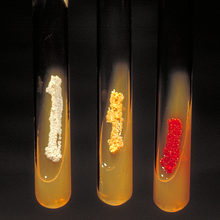Micromonosporaceae
| Micromonosporaceae | |
|---|---|

| |
| Scientific classification | |
| Domain: | |
| Phylum: | |
| Class: | Actinobacteria
|
| Order: | Micromonosporales Genilloud 2015[1]
|
| Family: | Micromonosporaceae Krasil'nikov 1938 (Approved Lists 1980)
|
| Genera[2] | |
|
See text. | |
| Synonyms | |
|
Synonyms of Micromonosporales
Synonyms of Micromonosporaceae
| |
Micromonosporaceae is a family of bacteria of the class Actinobacteria. They are gram-positive, spore-forming soil organisms that form a true mycelium.
Genera[]
- Actinocatenispora Thawai et al. 2006
- Actinoplanes Couch 1950 (Approved Lists 1980)
- Actinorhabdospora Mingma et al. 2016
- Allocatelliglobosispora Lee and Lee 2011
- Sun et al. 2019
- Asanoa Lee and Hah 2002
- Asano and Kawamoto 1986
- Catelliglobosispora Ara et al. 2008
- Yokota et al. 1993
- Tamura et al. 1994
- Dactylosporangium Thiemann et al. 1967 (Approved Lists 1980)
- Hamadaea Ara et al. 2008
- Krasilnikovia Ara and Kudo 2007
- Longispora Matsumoto et al. 2003
- Luedemannella Ara and Kudo 2007
- Liu et al. 2017
- Micromonospora Ørskov 1923 (Approved Lists 1980)
- Phytohabitans Inahashi et al. 2010
- Li et al. 2011
- Kane 1966 (Approved Lists 1980)
- Wiese et al. 2008
- Plantactinospora Qin et al. 2009
- Tamura et al. 2006
- Ara et al. 2008
- Matsumoto et al. 2014
- Monciardini et al. 2009
- Salinispora Maldonado et al. 2005
- "Solwaraspora" Magarvey et al. 2004[3]
- Tamura et al. 1997
- Virgisporangium corrig. Tamura et al. 2001
- "Wangella" Jia et al. 2013[4]
Phylogeny[]
The currently accepted taxonomy is based on the List of Prokaryotic names with Standing in Nomenclature (LPSN).[2] The phylogeny is based on whole-genome analysis.[5][a]
| |||||||||||||||||||||||||||||||||||||||||||||||||||||||||||||||||||
Notes[]
- ^ Actinorhabdospora, Allocatelliglobosispora, Allorhizocola, Catellatospora, Couchioplanes, Krasilnikovia, Luedemannella, Mangrovihabitans, Phytohabitans, Phytomonospora, Pilimelia, Planosporangium, Plantactinospora, Polymorphospora, Rhizocola, Rugosimonospora, Spirilliplanes, and Virgisporangium are not included in this phylogenetic tree.
References[]
- ^ Genilloud O (2012). "Order XI Micromonosporales ord. nov.". In Goodfellow M, Kämpfer P, Trujillo ME, Suzuki K, Ludwig W, Whitman WB (eds.). Bergey's Manual of Systematic Bacteriology. 5 (2nd ed.). New York: Springer. p. 1035.
- ^ a b Euzéby JP, Parte AC. "Micromonosporaceae". List of Prokaryotic names with Standing in Nomenclature (LPSN). Retrieved June 8, 2021.
- ^ Magarvey NA, Keller JM, Bernan V, Dworkin M, Sherman DH (2004). "Isolation and Characterization of Novel Marine-Derived Actinomycete Taxa Rich in Bioactive Metabolites". Applied and Environmental Microbiology. 70 (12): 7520–7529. Bibcode:2004ApEnM..70.7520M. doi:10.1128/AEM.70.12.7520-7529.2004. PMC 535209. PMID 15574955.
- ^ Jia, Feiyu; Liu, Chongxi; Wang, Xiangjing; Zhao, Junwei; Liu, Qianfeng; Zhang, Ji; Gao, Ruixia; Xiang, Wensheng (2013). "Wangella harbinensis gen. nov., sp. nov., a new member of the family Micromonosporaceae". Antonie van Leeuwenhoek. 103 (2): 399–408. doi:10.1007/s10482-012-9820-1. PMID 23011010. S2CID 14565146.
- ^ Nouioui I, Carro L, García-López M, Meier-Kolthoff JP, Woyke T, Kyrpides NC, Pukall R, Klenk HP, Goodfellow M, Göker M (2018). "Genome-Based Taxonomic Classification of the Phylum Actinobacteria". Front. Microbiol. 9: 2007. doi:10.3389/fmicb.2018.02007. PMC 6113628. PMID 30186281.
Categories:
- Micromonosporineae
- Soil biology
- Actinobacteria stubs